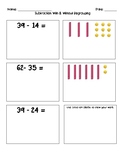

#Subtraction with base ten blocks worksheets pdf#
You can print a copy of your results from this page, either as a pdf or as a paper copy.įor incorrect responses, we have added some helpful learning points to explain which answer was correct and why. This will take you to a new webpage where your results will be shown. Our quizzes have been created using Google Forms.Īt the end of the quiz, you will get the chance to see your results by clicking 'See Score'. This page involves counting in hundreds, tens and ones. take a number written in expanded form and work out its value, e.g.write 3 digit numbers in expanded form, e.g.identify the number of 1s, 10s or 100s in a 3 digit number, and say what the value of each digit is.count on or back by 1s, 10s and 100s from a range of starting points (up to 1000).count by 1s, 2s, 5s, 10s, 100s for at least 25 terms.read, write, compare and order numbers up to 1000.They can count accurately by 1s, 10s and 100s from different starting points,Īnd can split numbers up into hundreds, tens and ones.īy the end of 2nd grade, most children should be able to: Their Place Value learning has begun!Īt a higher level, children know their place value up to 1000. They learn to count up to higher numbers like 20 or 30.Įventually, they manage to learn to count up to 100, and that numbers up to 100 can be split up into tens and ones. Next, they learn to count objects and numbers of things that are in front of them and learn 1:1 correspondence when counting.ĭuring this stage children are still learning their number sequence, and that numbers continue past 10. When children first learn to count, they learn the number sequence, usually up to ten, but without an understanding of what the numbers mean. Four 1-digit numbers e.g.Counting is one of the very first skills young children learn to do in their math journey.2-digit – 2 -digit – no regrouping e.g.2-digit – 1-digit – no regrouping e.g.2-digit + 2 -digit – no regrouping e.g.2-digit + 1-digit – no regrouping e.g.2-digit & 1-digit – no regrouping e.g.Adding 3 Numbers (in easiest order) e.g.Adding & Subtracting with 3 Numbers (e.g.Number Bonds To 100 (with blank number lines) (From Worksheet).


Making (Bridging) Multiples of 10 e.g.Number bonds to 50 e.g.17 + _ = 50 (From Worksheet).Number bonds to 40 e.g.12 + _ = 40 (From Worksheet).Number bonds to 30 e.g.26 + _ = 30 (From Worksheet).Number bonds to 20 e.g.8 + _ = 20 (From Worksheet).Help with Pre-Algebra: Simple Equations (From Lesson).Use place value understanding and properties of operations to add and subtract Similar to the above listing, the resources below are aligned to related standards in the Common Core For Mathematics that together support the following learning outcome: Subtraction with regrouping (with place value blocks).Addition & Subtraction: 3 of 3 (within 1000).Addition & Subtraction: 2 of 3 (within 1000).Addition & Subtraction: 1 of 3 (within 1000).Understand that in adding or subtracting three-digit numbers, one adds or subtracts hundreds and hundreds, tens and tens, ones and ones and sometimes it is necessary to compose or decompose tens or hundreds. The various resources listed below are aligned to the same standard, (2NBT07) taken from the CCSM ( Common Core Standards For Mathematics) as the Addition and subtraction Worksheet shown above.Īdd and subtract within 1000, using concrete models or drawings and strategies based on place value, properties of operations, and/or the relationship between addition and subtraction relate the strategy to a written method.


 0 kommentar(er)
0 kommentar(er)
